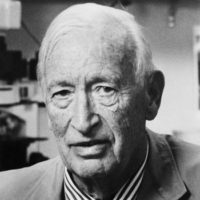
Paul C. Zamecnik
Massachusetts General Hospital
For brilliant and original science that revolutionized biochemistry and spawned new avenues of scientific inquiry.
Few scientists make a contribution of the monumental importance of Paul Zamecnik. Fewer still make two.
But in a 60-year career characterized by sheer scientific originality and brilliance, this molecular biologist first provided the tools for deciphering the genetic code and then later was the first to conceive of the successful use of antisense DNA for the highly selective inhibition of gene expression.
In the 1950s, the mechanism of protein biosynthesis was a “black box.” Prevailing ideas were naïve and without experimental support. Some biochemists had advanced the idea that proteins were assembled by the action of proteolytic enzymes in a reverse reaction.
But it was Paul Zamecnik and his team who unlocked the mystery, defining the biochemistry of amino acid activation and assembling its proteins. This provided the first hard evidence for transfer RNA, the key piece in the puzzle of how genetic information in DNA is translated into the specific sequence of amino acids that gives each protein its distinct molecular identity. His work provided a totally new picture of protein synthesis—one that did not simply overthrow a previous idea, but filled a void.
The key was the development of cell-free systems capable of carrying out net peptide bond formation, using 14C-amino acids for the first time. His results and discovery of an entirely new chemical mechanism were received throughout the scientific community with enormous enthusiasm.
Dr. Zamecnik’s next major discovery was the conceptualization and demonstration that antisense DNA, in which short chains of DNA, chemically synthesized to be complementary to selected RNA targets in the cell, are used to selectively inactivate the expression of specific genes. This groundbreaking work has spawned the development of a new field of research, a novel approach to investigating new drugs using antisense DNA to block or stop the replication of viruses. Clinical trials of antisense DNA drugs for AIDS, cancer and infectious disease are conducted now in laboratories around the world because of Paul Zamecnik’s discoveries, some of which are in his own laboratory, where he continues to be a major player.
To Paul C. Zamecnik, for brilliant and original science that revolutionized biochemistry and created an entirely new field of scientific inquiry, this 1996 Albert Lasker Award for Special Achievement in Medical Science is given.
Award presentation by Joseph Goldstein
Winston Churchill once said that there are two kinds of success—initial success, which many achieve, and ultimate success, which only a handful achieve. At the risk of being audacious, I would like to modify Churchill's quote and say there are three kinds of success—initial, sustained, and ultimate. Paul Zamecnik, the recipient of the Albert Lasker Award for Special Achievement in Medical Science, is one of those rare birds who has achieved all three kinds of success—initial, sustained, and ultimate.
Dr. Zamecnik's initial success is exemplified by his early studies 50 years ago when he was the first to develop a cell-free system for manufacturing proteins. His sustained success is exemplified by a remarkable succession of monumental discoveries, each of which opened a new field of research. In the mid-1950s, he discovered how amino acids are activated by ATP for entry into the protein synthesis pathway. He then discovered that a small soluble RNA—later called transfer RNA—was the adaptor molecule required in Francis Crick's theory of how the DNA message is translated into the amino acid sequence. Zamecnik's identification of transfer RNA is a landmark in the history of science. In this one experiment, biochemistry and genetics became fused into the new science of molecular biology, and the door was opened for cracking the genetic code.
Most recently, in 1978 Dr. Zamecnik opened another door to a new field—the use of antisense DNA to selectively block gene expression. Antisense DNA is now a major research tool in modern biomedical research and has spawned many new biotechnology companies that specialize in antisense DNA as a therapy for human disease. Today, 13 clinical trials with antisense drugs are underway to treat patients with AIDS, cytomegalovirus, other infectious diseases, and cancer.
In Churchillian terms, Dr. Zamecnik's ultimate success is exemplified by a rare type of scientific distinction achieved by only a handful of scientists who are held in universally high esteem by their colleagues because of certain human qualities—honesty, kindness, unselfishness, originality, and wisdom.
It's a real honor to celebrate the three successes of Paul Zamecnik.
